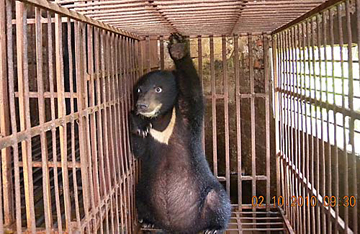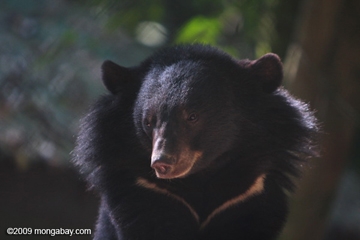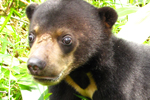Surveying 13 nations and territories in Asia, the wildlife trade organization TRAFFIC found that the bear bile trade remains practically ubiquitous in the region. In many cases the trade, which extracts bile from captive bears’ gall bladders for sale as a pharmaceutical, flouts both local and international law, including Appendix I of Convention on International Trade in Endangered Species of Wild Fauna and Flora (CITES ). The international organization outlaws cross-boundary trading with the Asiatic black bear (Ursus thibetanus), the sun bear (Helarctos malayanus), or the brown bear (Ursus arctos), the three species used in the bear bile trade.
“Both the Asiatic black bear and the Sun bear are threatened by poaching and illegal trade. The demand for bile is one of the greatest drivers behind this trade and must be reduced if bear conservation efforts are to succeed,” said Kaitlyn-Elizabeth Foley, lead author of the report and Senior Programme Officer of TRAFFIC Southeast Asia.
 Bear cub at a farm in Hanoi, Vietnam. Photo © M. Silverberg/TRAFFIC Southeast Asia. |
The report by TRAFFIC found the bear bile trade alive in well in all 13 nations and territories it surveyed, aside from Macao. The trade was most visible in China, Hong Kong, Malaysia, Myanmar, and Vietnam, where half of the traditional medicine stores visited carried bear bile.
In a number of countries—Cambodia, Malaysia, Myanmar, Singapore, Thailand and Vietnam—traditional medicine purveyors flouted national law by carrying bear bile. But even when legal, the trade likely still flouted international law. According to TRAFFIC, the bear products regularly pass international boundaries, with some bears having been imported from as far away as Russia.
“Unbridled illegal trade in bear parts and products continues to undermine CITES which should be the world’s most powerful tool to regulate cross-border wildlife trade,” said Foley.
 Asiatic black bear at rescue center in Laos. Photo by: Rhett A. Butler. |
The report found that bear bile had even gone beyond its use as a traditional medicine, advertized in as diverse products as shampoo, soda, and cough drops. Other sources have reported bear bile wine.
Most bear ‘farms’, where the bears are kept in small cages awaiting the extraction of bile from their gall bladder, did not have breeding programs, making it likely that bear victims were being stolen illegally from the wild.
While bile, and the gall bladder itself, remain the most popular parts of bears in Chinese traditional medicine, other parts are also in demand including paws, skin, claws, and teeth.
Animal rights activists have long argued that bear bile is severely cruel. Bears spend their lives in cages little bigger than themselves, while having their bile extracted frequently, a painful process given the bears’ reported reaction to it. Activists have stated that bears in these farms as under considerable stress and display abnormal behavior. Once a bear stops producing bile, it is usually killed to harvest its other parts.
The sun bear is listed by the IUCN Red List as Endangered, the Asiatic black bear is considered Vulnerable, while the brown bear is listed as Least Concern.
Related articles
Pet trade, palm oil, and poaching: the challenges of saving the ‘forgotten bear’

(03/20/2011) Siew Te Wong is one of the few scientists who study sun bears (Ursus malayanus). He spoke with Laurel Neme on her “The WildLife” radio show and podcast about the interesting biological characteristics of this rare Southeast Asian bear, threats to the species and what is being done to help them. Sun bears are the smallest of the eight bear species. They’re about half the size of a North American black bear and typically sport a tan crescent on their chests. Similar to the “moon bear,” or Asian black bear, the sun bear’s name comes from this marking, which looks like a rising or setting sun.
Photos: rescued sun bears in Borneo moved to new facility

(04/08/2010) Rescued sun bears in Sabah, Borneo are getting a new home this week. The Bornean Sun Bear Conservation Center (BSBCC) has finished Phase 1 of its construction of a new home for the bears. Eventually the center will include visitor facilities and observation gallery where tourists will have the chance to watch the bears. For now, though, the bears will enjoy brand new state-of-the-art facilities and, for the first time, access to a pristine forest.
Video: rare footage of the sun bear, the world’s smallest, making a nest in the canopy
(12/06/2009) Sun bear expert, Siew Te Wong, has captured rare footage of the world’s smallest bear making a nest high in the canopy. The sun bear in the video is a radio-collared individual that Wong is keeping tabs on in Borneo.